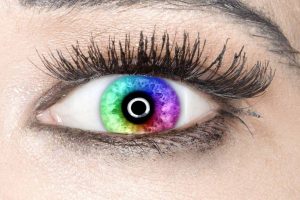An estimated 1 in 12 men and 1 in 200 women has some degree of color blindness.
Color blindness is not an actual blindness, but rather an inability or reduced ability to perceive differences between colors.
Color blindness, also called color vision deficiency, can be a partial or total deficiency, though total color blindness is less common.
What causes color blindness?
Color blindness is generally inherited, but can also result from disease, brain injury, and in rare cases, from side effects to certain medications.
When certain nerves, called photoreceptors, are not present in the retina, color blindness can result. For example, if the nerve that detects the color red is missing, then you will not be able to distinguish the different shades of red, and instead, these colors will be confused with other colors.
Types of color blindness
There are two main types of color blindness, both of which lead to the confusion of two colors and result in the appearance of grey or brown instead of the true color.
Red-green is the most common type of color blindness. It is often inherited from the mother’s side on the X chromosome. With this condition, the darker red and green colors are generally both seen as a muddy brown or grey color.
Blue-yellow is a less common type of color blindness that generally occurs from damage to the optic nerve or retina. With this condition, the light blue and yellow colors are generally both seen as a light brown or grey color.
If you suspect your child is color-blind, contact an eye doctor near you, who can diagnose and treat the condition.
SEE RELATED: 2021 Update: Parent’s Checklist for Vision Therapy
What are color blind glasses?
Color blind glasses contain lenses with special filters that may help people with red-green color blindness to see colors more accurately.
These glasses are made with specific materials that absorb and filter out the colors that exist between green and red on the light spectrum— specifically those that cause the brain to become “confused”— leading to distorted color vision.
These glasses come in a variety of tints, most commonly orange/red, but yellow and clear have been shown to be effective.
In addition, the filters in the lenses block some of the light from coming through to ensure that the remaining red and green colors don’t overlap. With less color overlap, the brain is able to perceive a clearer signal and distinguish between the colors more accurately.
Unfortunately, there is no cure for color blindness. However, color blind glasses can offer a more accurate perception of color, enabling people with color blindness to experience a greater array of color schemes— at least while the glasses are worn.
The downside to color blind glasses is that most of these specialized lenses are designed to correct mild red-green color blindness, leaving fewer options for those with severe red-green color blindness and blue-yellow color blindness.
Schedule an appointment with an eye doctor to learn more about color blind glasses and find out if they are right for you.
LEARN MORE: Vision Therapy for Children
With color blind glasses you can experience the world in a more colorful way, enjoying a greater quality of life.


